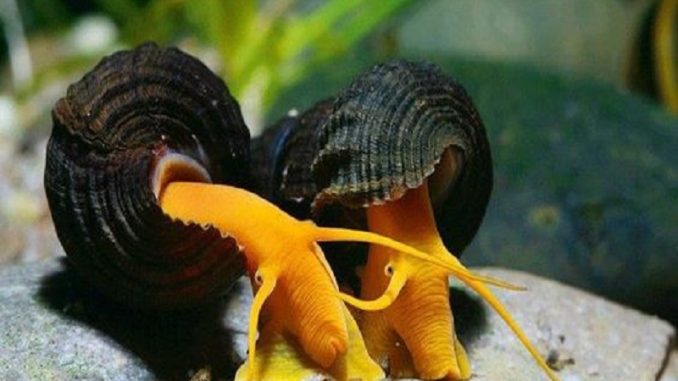
If you are looking for a great cleanup crew, consider adding some Rabbit Snails to your community aquarium. Not only will these snails help keep your tank sparkling clean, but they also have great personalities and a peaceful disposition, making them great tank mates (for other peaceful fish, of course.)
You do not want to add Rabbit Snails to a tank with aggressive fish who will mistake them for a midnight snack.
In addition to the benefits they bring to the home aquarium, Rabbit Snails have an unusual and appealing appearance that will add an exotic flair to your aquarium. They are fairly easy to care for, as long as you can control ammonia and nitrate levels in the tank.
In this article, I’ll cover everything you need to know to successfully add some Rabbit Snails to your community tank, including behavior, appearance, tank requirements, and nutritional needs. You won’t grow tired of watching them explore the tank, dragging along their unicorn-horn shells.
TABLE OF CONTENTS
Rabbit Snail Facts & Overview
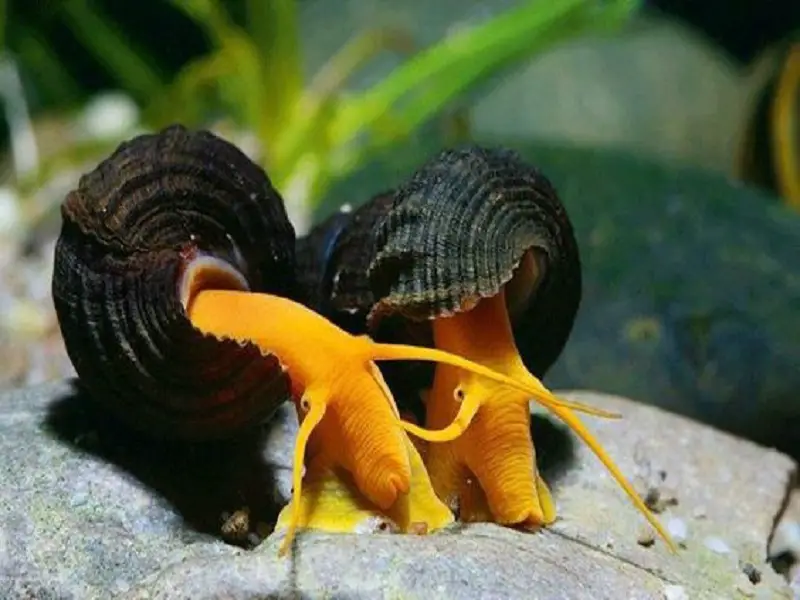
| Category | Rating |
| Care Level: | Easy |
| Temperament: | Peaceful |
| Color: | Brown and yellow |
| Lifespan: | 1-3 years |
| Size: | 3 inches |
| Diet: | Omnivore |
| Family: | Pachychilidae |
| Minimum Tank Size: | 30 gallons |
| Tank Setup: | Freshwater with plants and rocks |
| Compatibility: | Peaceful community |
Rabbit Snails, the scientific name Tylomelania, originate in Sulawesi, Indonesia, where they can be found in lakes in the mountains. Unique in appearance and peaceful in character, Rabbit Snails add a special touch to your community aquarium of at least 30 gallons.
In addition, they are great tank cleaners and will keep you entertained with their curious exploration of the aquarium.
Although there are approximately 50 different species of Rabbit Snails that have been identified, a limited number of these species, also known as Poso Snails and Elephant Snails, are available in the aquarium hobby.
These freshwater snails differ from traditionally observed snails in that they are larger, more active, and spawn fewer babies than other snail species.
Regardless of the species of Rabbit Snail that you end up with, care needs will be the same–most of the difference between species is tied to color differences.
Fun Fact: Some in the aquarium hobby like to refer to Rabbit Snails as Bunny Snails.
With proper water parameters and optimal care, Rabbit Snails have a lifespan of about 3 years in captivity.
They prefer warmer water that matches their tropical climate from the wild, so even though they have a rather wide range of acceptable temperatures, they will thrive in warmer water. This is especially true when it is time for them to breed.
Typical Behavior
Generally, when we think of snails, we envision really slow-moving creatures who pretty much hang out in the same place all day. Rabbit Snails do not fit this stereotype: they are really active and love to wander around the tank all day. You will have fun watching them.
As they walk, they drag their foot, which moves through muscle contractions. As the muscles contract, their shells arch and they pull their spiral shell along with them.
What is the foot, anyway? The Rabbit Snail “foot” actually refers to its body. Its whole body is one big muscle that contracts to allow it to “step” forward.
And during their wandering, they will be completely uninterested in anyone around them. They are loners, but not afraid to be out and about in public.
Most of what they do all day is look for ways to clean your tank. If only we had Rabbit Snails to clean our homes! They scoop up algae and detritus so you don’t have buildup in your aquarium.
Pro tip: Sometimes Rabbit Snails just need a day of rest. Don’t get too worried if your Rabbit Snail retreats into its shell and does not seem to be moving. They will likely pop back into motion after they have rested.
Appearance
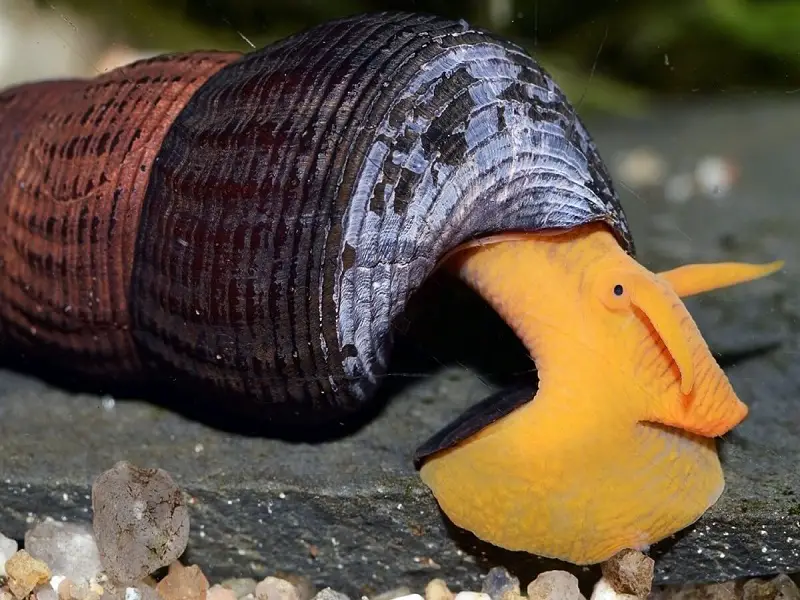
Rabbit Snails grow to about 3 inches (7.6 cm) in captivity. Named for their appearance, Rabbit Snails have two dropping antennae that resemble rabbit ears, as well as rabbit-like facial features.
They have long faces and downward-facing mouths, which allow them to reach food from the substrate. Unlike the slimy snails that you are used to seeing, Rabbit Snails are pretty dry and wrinkly looking. In fact, sometimes these snails are known as Elephant Snails.
There are myriad types of Rabbit Snails, which can be distinguished by their color and are named as such. Examples of Rabbit Snails available for home aquariums include:
- Black Rabbit Snails
- Chocolate Rabbit Snails
- Golden Rabbit Snails
- White Spotted Rabbit Snails.
- Yellow Rabbit Snails
Rabbit Snails have fabulous shells that vary in color. They are spiral-shaped and look like long cones. Colors vary: some shells have a dark hue and some are spotted. If you look from the top, you can see spiral grooves that wrap around the whole whorled shell.
Fun fact: Due to corrosion and injury, these spiral grooves may become more shallow as a Rabbit Snail ages.
Rabbit Snail shells are longer and pointier than other snail shells. The opening is shaped like an oval, where you will find the operculum, or trap door, where the Rabbit Snail can hide in case of threat or danger. The operculum does not provide complete protection since it does not cover the whole opening, leaving the Rabbit Snails partially exposed to predators.
The body/foot of the Rabbit Snail is particularly beautiful and colorful.
Habitat and Tank Conditions
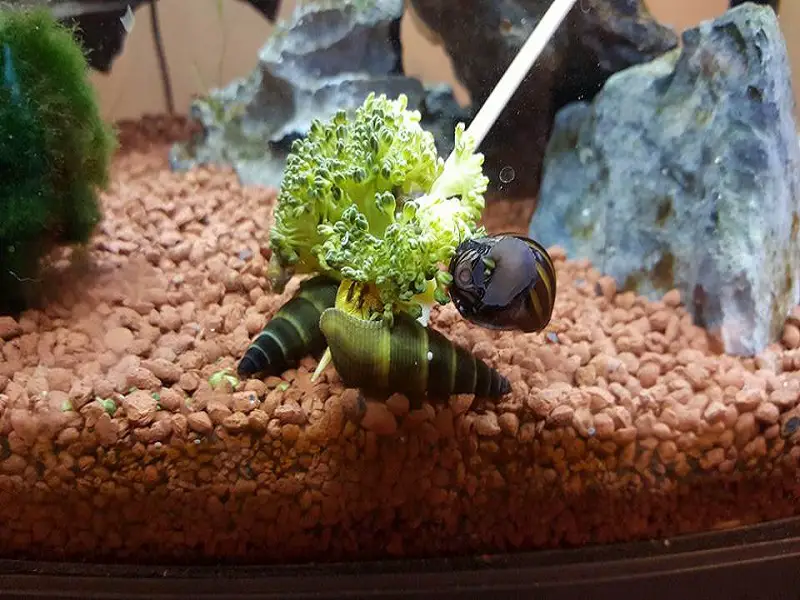
Starting with a 30-gallon tank is the first recommendation for Rabbit Snails. They need enough space to move around the tank; luckily, they are suited to be paired with peaceful fish, so you can easily add fish to the mid and top levels of the tank to fully populate the tank without overcrowding it.
For substrate, choose fine sand so that the Rabbit Snails do not scrape themselves on the substrate. They are burrowers and can go down pretty deep. The sand is also similar to what they will encounter in their natural habitat in Indonesia, which makes them happy.
Rabbit Snails also do well with planted and floating greenery. As leaves fall off and drift to the substrate, Rabbit Snails will eat the detritus. The only plant you might want to avoid is the Java Fern, which they tend to eat live if they are hungry. But if you’re feeding them enough, you shouldn’t run into an issue.
Although Rabbit Snails can’t jump out of the tank-like some aquarium fish, they are able to climb up the side and out of the tank, so you will need a tight-fitting lid for these guys.
Because of their sensitivity to ammonia and nitrates, you will also need a pretty strong filter to rid the water of these harmful elements.
Pro tip: Rabbit Snails may get stuck on the filter tubes, so invest in a sponge prefilter that will protect your Rabbit Snails from getting hurt.
Water Conditions
For their health and well being, as well as shell integrity, Rabbit Snails have specific water requirements. They prefer alkaline water so that their shells do not corrode.
If their shells are damaged, they will not be as protected from predators. They also thrive more in warmer water, especially when it is time for them to breed.
Ideal Water Parameters for Rabbit Snails:
- Water temperature: 68°F to 86°F (20°C to 30°C)
- pH levels: 7.3 to 8.5
- Water hardness: 2 to 15 dKH
Until you establish stability in parameters, you should perform multiple water checks to make sure your Rabbit Snails are safe and comfortable.
What Size Aquarium Do They Need?
You might be surprised by my 30-gallon tank recommendation for snails, but remember that Rabbit Snails are quite a bit larger than other snails, so they need more space to slide back and forth across the tank scooping up all your algae.
Additionally, a smaller aquarium means that there is less dilution of ammonia and nitrates due to the fact that there is less water. High levels of nitrate and ammonia can be harmful to Rabbit Snails, so a larger tank allows the ammonia and nitrates to be diluted to a safe level for Rabbit Snails.
Tank Mates
Rabbit Snails are super peaceful and are not a threat to any other species. Most of the considerations that are relevant involve not placing Rabbit Snails with species that will be a threat to them. It’s important to pair them with tank mates that are not aggressive or likely to eat them.
Inappropriate Tank Mates for Rabbit Snails
Appropriate Tank Mates for Rabbit Snails
- Amano Shrimp
- Celestial Pearl Danio
- Congo Tetra
- Dwarf Gourami
- Ghost Shrimp
- Guppies
- Honey Gourami
- Otocinclus
- Pearl Gourami
- Ramshorn Snail
- Sparkling Gourami
Keeping Rabbit Snails Together
You can’t help but keep Rabbit Snails together because they are going to reproduce. But these are super chill snails, and they get along well. They are not territorial or aggressive with each other and will do fine. The only thing you would want to watch out for is having too many Rabbit Snails and not enough algae and detritus to go around.
Diet
Rabbit Snails are scavengers, and one of the reasons that they are desirable aquarium dwellers is that they are tank cleaners. Rabbit Snails will happily make sure to cut down on the number of algae and detritus in your tank.
They will also snack on leftover food that floats down from mid and top-level fish. However, they do need you to provide them with sources of nutrition in order to ensure sufficient nutrition. Calcium is necessary to keep their shells strong and protect them from predators. Some healthy options to offer your Rabbit Snails include:
- Algae wafers
- Blanched broccoli
- Blanched spinach
- Sinking Pellets
Care
Rabbit Snails will not need a whole lot of extra care as long as you provide them with optimal water parameters. They are not going to be at risk of contracting the common diseases that attack aquarium fish, such as Ich (they can be carriers, though.)
Maintaining water stability will go a long way to ensuring that your Rabbit Snails thrive–instability increases stress, threatens their health, and compromises shell integrity.
One thing that is a threat to Rabbit Snails is leeches, which can latch onto the inside of the Rabbit Snail’s shell and eat the snail’s soft body. Leeches are extremely invasive, and if you don’t address the problem swiftly and thoroughly, leeches will breed inside your tank and spread to other aquarium inhabitants.
To prevent an utter invasion, address leeches pre-infestation; if you see one (or more), soak the snail in salty water for 15 minutes to dislodge the leeches.
You can kill any leeches still attached to your snail with cotton soaked in alcohol.
Pro tip: Leeches will usually come along for the ride, squatting with wild-caught Rabbit Snails. The risk for infestations can be greatly reduced by quarantining Rabbit Snails (and any other inhabitants, decorations, or plants) before introducing them to the community tank.
One final note about care is that even though Rabbit Snails are not in danger from parasitic infections such as ich, they are in danger of illness and death from most of the medications that are commonly used to treat these diseases. Copper is deadly for Rabbit Snails, so if you are using a medication to treat
your fish, check the label to see if it has copper. If it does, treat your fish in a separate tank so that the Rabbit Snails are not exposed to the copper.
Breeding
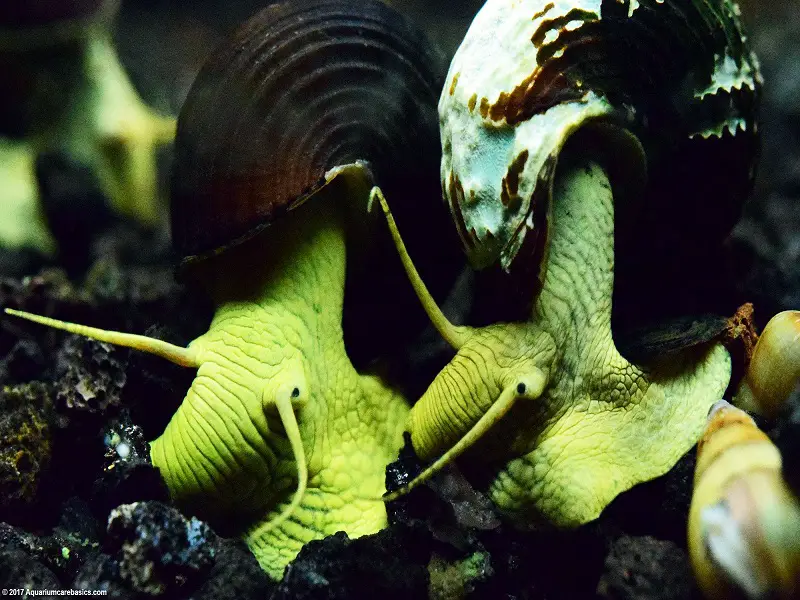
Despite their name, Rabbit Snails are not super fast breeders. Unlike other snails, they only have one or two baby snails per breeding cycle, so overpopulation will not be an issue.
In a process that is fascinating to witness, the male Rabbit Snail passes a ball of sperm to the female, who hangs on to it until she is ready to lay her eggs (or egg). The egg is gelatinous and resembles a small pearl. After a very short incubation time, the baby snail emerges from the egg, looking like a mini Rabbit Snail.
As soon as the carbon copy babies are born, complete with a fully formed shell, they will start their lives as scavengers, searching for food right away.
Are Rabbit Snails Suitable for your Aquarium?
Rabbit Snails might be just the snail you have been waiting for. It’s fun to watch them hopping and skipping across your aquarium; they are excellent cleaners, and they won’t overwhelm your tank with more baby Rabbit Snails than you want.
You’ll also impress your friends and family with this out of the ordinary snail that really has a different vibe than the snails we are accustomed to seeing.
They will really give your community aquarium an exotic look.
Are Rabbit Snails your favorite community aquarium inhabitant? Let us know why in the comments below…
FAQ
Do I need to give my Rabbit Snails algae wafers?
Although Rabbit Snails will eat algae off the sides of your aquarium, it’s a good idea to supplement with some algae wafers. Although they are omnivores, Rabbit Snails subsist primarily on algae, so they need supplements.
Also, if they do not get enough nutrition, they may munch on your live plants.
Do I need to have a separate breeding tank?
No, Rabbit Snails don’t require any special conditions for breeding, although they do like the water on the warmer side when it is time to reproduce. In cooler water, their metabolism will slow down, which could prevent successful breeding.
What is the average lifespan for Rabbit Snails?
Rabbit Snails have an average lifespan of 3 years in captivity. In less than optimal conditions, your Rabbit Snails may make it for 1-2 years.
How many eggs does the female Rabbit Snail lay at a time ?
Surprisingly, Rabbit Snails do not reproduce to the extent that other snails do. The female Rabbit Snails sometimes lays 2 or 3 eggs, and sometimes only one in a breeding cycle.
I have a community tank with Cichlids. Can I add some Rabbit Snails to the community ?
Unfortunately not. Rabbit Snails are the most peaceful aquarium mate you will find, but they must be housed with other peaceful, non-aggressive fish. Cichlids are likely to eat them.
My Rabbit Snail is curled up in its shell and isn’t moving. Should I be concerned?
I would not worry about that too much. Rabbit Snails can stay awake for more than 30 hours at a time, and they are very active while they are awake. However, all this activity, they are tired, and it is not unusual for them to curl up and sleep for long periods.
Do I need to add a calcium supplement for my Rabbit Snails?
Rabbit Snails will appreciate a cuttlebone added to the aquarium. Extra calcium will make the Rabbit Snail’s shell stronger, which will help keep them safe. Be sure to boil the cuttlebone in advance, though, so that it will sink to the substrate and the Rabbit Snails can enjoy it.

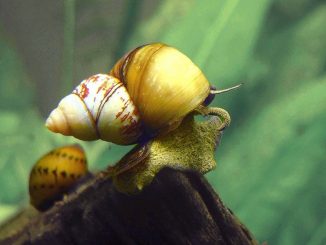
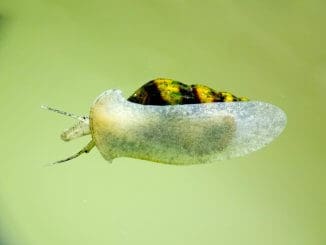
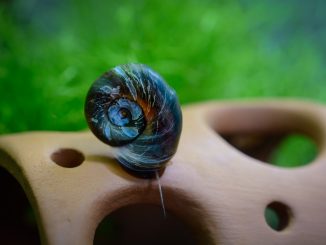

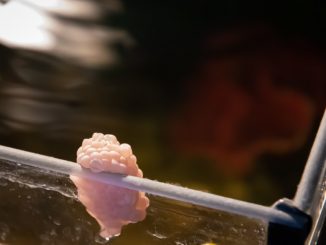
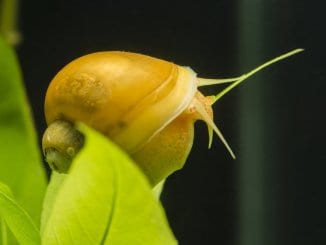
Hi, so I have a 20 gallon and I was wondering would 2 rabbit snails be okay? I have guppies and platies, and I do a 25% water change every week. Thank you for your information.
I heard guppies may snack on their antennae